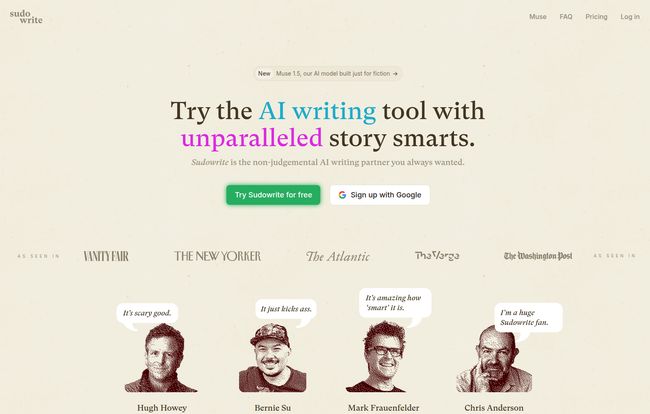The cursor blinked. Mocking me. Again. We’ve all been there, right? Staring at a blank page, the ghost of a brilliant idea flickering just out of reach. For years, the solitary struggle was just part of the deal. The price of admission for being a writer. You, your story, and a whole lot of coffee (or tea, I don’t judge).
Then AI writing tools crashed the party. At first, I was a hard skeptic. I’ve been in this SEO and content game for a long time, and I’ve seen tools come and go. Most of them felt… clunky. They could string words together, sure, but they had all the soul of a microwave manual. Great for a quick product description, but for a novel? For a world born from your imagination? No thanks.
But then I kept hearing whispers in writing communities about a different kind of tool. Something built from the ground up for storytellers. Something called Sudowrite. The buzz was that it wasn't a soulless content machine, but a partner. A muse on-demand. So, I pushed my skepticism aside, signed up, and decided to see if it could really help me slay the dreaded blinking cursor.
So, What Exactly is Sudowrite?
Let's get one thing straight: Sudowrite isn’t here to write your novel for you. If that’s what you’re looking for, you’re in the wrong place. Think of it less as a ghostwriter and more as a brainstorming buddy who’s had way too much coffee and read the entire internet. It’s an AI partner designed specifically for the weird, wonderful, and often frustrating process of writing fiction.
It was created by writers, and it shows. The entire platform feels less like a tech product and more like a creative's workspace. It’s here to help you get unstuck, to add a splash of color to a drab scene, or to throw a dozen crazy plot twists at the wall to see what sticks. It's about augmenting your process, not automating your soul.
My Favorite Sudowrite Features (And How I Used Them)
Okay, enough with the philosophy. What can this thing actually do? I spent a couple of weeks putting it through its paces on a short story that had been gathering dust. Here’s the breakdown of the features that really stood out.
The 'Write' Button: More Than Just a Blank Page Filler
This is the main event. You give it some context—the last couple of paragraphs you wrote—and it suggests what might come next. What I loved is that you can choose different AI models, so you're not getting the same generic voice every time. It's like having a panel of different authors to consult. Sometimes it would spit out something absolutely perfect, a sentence I would have taken an hour to craft. Other times, it was… a bit out there. But even the weird suggestions were useful, sparking an idea I wouldn’t have had otherwise. It’s a fantastic way to break inertia.
'Expand' and 'Rewrite': Your Built-in Editor and Scene-Stretcher
These two became my best friends. Got a sentence that’s technically correct but boring as heck? Highlight it, hit Rewrite, and Sudowrite gives you a handful of alternatives, from the poetic to the punchy. It’s like a thesaurus that actually understands context and subtext.
The Expand feature is pure magic for those moments when you know what needs to happen but can’t find the words. I had a line: “She walked into the dusty old bookstore.” I highlighted it, clicked 'Expand,' and asked it to add sensory details. It came back with the smell of aging paper and leather, the creak of the floorboards, the way dust motes danced in the slivers of light from the window. It didn’t write the scene for me, it gave me the raw clay to shape it myself. That's a key distinction.
Brainstorm, Canvas, and Story Bible: The World-Building Toolkit
Now this… this is where Sudowrite really separates itself from the general-purpose AI crowd. For anyone who has ever tried to keep a sprawling fantasy or sci-fi world straight, you know the pain. Sticky notes, chaotic Word docs, a half-forgotten spreadsheet. It’s a mess.
The Story Bible feature is a centralized place to keep all your lore. You create character sheets, describe locations, outline your magic systems. The best part? The AI knows this stuff. When you use the 'Write' feature later, it will pull from your Story Bible to ensure your blue-eyed protagonist doesn't suddenly have brown eyes in chapter 12. It’s a game-changer for consistency.
The Canvas is a visual mind-mapping space. You can lay out your plot points on cards, generate summaries for each, and then have the AI generate a full outline based on your structure. It's an incredible tool for visualizing your story's arc before you get lost in teh weeds of prose. It helps you see the whole forest, not just the trees.

Visit Sudowrite
The Elephant in the Room: AI, Plagiarism, and Authenticity
Look, I get it. The idea of an AI “writing” fiction can feel… icky. A lot of writers I respect are worried it will lead to a glut of generic, soulless stories. And they’re not entirely wrong to be concerned. If used poorly, that’s exactly what could happen.
But in my experience, Sudowrite is a tool, just like a word processor or a grammar checker. A hammer doesn’t build a house by itself; it’s about the skill of the person wielding it. Sudowrite doesn’t have your voice, your life experiences, or your unique spark. What it has is data—and it’s incredibly good at arranging that data in interesting ways. Your job as the author is to be the curator, the editor, the artist who shapes its suggestions into something that is truly yours.
What about plagiarism? The provided info says Sudowrite can be forced to plagiarize if you really push it, though it's against their terms of service. This comes down to user responsibility. Don't ask it to copy another author's style verbatim. Use it as an idea generator, not a content thief. And for what it's worth, Sudowrite is very clear: you own the copyright to your writing. They don’t claim any of it.
Let's Talk Money: Sudowrite Pricing and Plans
Alright, the all-important question: what does this magical writing partner cost? The pricing is credit-based, which is pretty standard for AI tools. How many words a credit gets you can vary, but I found the tiers to be pretty reasonable.
Here’s a quick rundown of their plans:
- Hobby & Student Plan: This one's about $10 per month and gets you 225,000 credits. It’s a great starting point if you’re just trying it out or working on short stories or school projects. Plenty to get your feet wet.
- Professional Plan: This is their most popular option at around $22 per month for 450,000 credits. They bill this as being perfect for longer works like a novel, and I'd agree. This is probably the sweet spot for anyone doing NaNoWriMo or seriously tackling a big project.
- Max Plan: For the power users and prolific indie authors, this plan is about $44 per month for a whopping 2,000,000 credits. The killer feature here? Your credits roll over for 12 months, so you don't lose what you don't use. That's a fantastic touch.
Is it worth it? Honestly, when you compare it to the cost of a professional developmental editor or even just the value of your own time, I think so. If it helps you finish one more chapter a week or helps you break a month-long block, it's already paid for itself.
Is Sudowrite Right for You? The Final Verdict
After my time with it, I'm a convert. A cautious one, but a convert nonetheless.
Sudowrite is an incredible tool for novelists, screenwriters, and hobbyist fiction writers who find themselves wrestling with plot holes, bland descriptions, or the sheer momentum-crushing force of writer’s block. If you are a world-builder who needs to keep track of a hundred different details, the Story Bible alone might be worth the price of admission.
Who is it not for? Probably non-fiction writers, journalists, or poets. The tools are so finely tuned for narrative storytelling that you'd be paying for features you just wouldn't use. Also, if you’re a purist who believes the struggle is a non-negotiable part of the art, then this tool might just frustrate you.
For everyone else, it’s a powerful, creative, and surprisingly fun co-pilot. It doesn’t take the wheel, but it’s great at pointing out interesting new roads to take.
Conclusion
The future of writing isn't some dystopian showdown between humans and machines. I truly believe it’s about collaboration. It’s about using smart tools to handle the grunt work so we can focus on what matters: the heart, the soul, and the message of our stories. Sudowrite is one of the first tools I’ve seen that really understands this. It respects the writer's role and aims to support, not supplant. If you’re a fiction writer on the fence about AI, I’d say give Sudowrite’s free trial a shot. You might just find the brainstorming partner you’ve been waiting for.
Frequently Asked Questions About Sudowrite
- Can Sudowrite write a whole novel for me?
- No, and that's by design. It's a collaborative tool meant to assist you, not replace you. It can generate scenes, suggest plot points, and help with descriptions, but you are the author and director of the project.
- Who owns the copyright to work created with Sudowrite?
- You do. Sudowrite is very clear in its policy that users retain full ownership and copyright of the content they create on the platform.
- Is Sudowrite better than ChatGPT for writing fiction?
- For fiction, I would say yes. While ChatGPT is a powerful generalist, Sudowrite's features like Story Bible, Canvas, Expand, and its focus on narrative structure are specifically tailored to the needs of novelists and screenwriters, giving it a significant edge for creative writing.
- Do the credits expire?
- On the Hobby & Student and Professional plans, credits reset monthly. However, on the Max plan, unused credits roll over and are valid for 12 months, which is a great benefit for writers with fluctuating output.
- Is Sudowrite hard to learn?
- Not at all. The interface is intuitive and designed to feel like a comfortable writing space. Most of the core features are just a click away, and it encourages experimentation. There's a slight learning curve to mastering all the tools, but you can get started in minutes.
Reference and Sources
- Sudowrite Official Website
- Sudowrite Pricing Page
- As cited on their homepage, Sudowrite has been featured in publications like The New York Times and The New Yorker.



